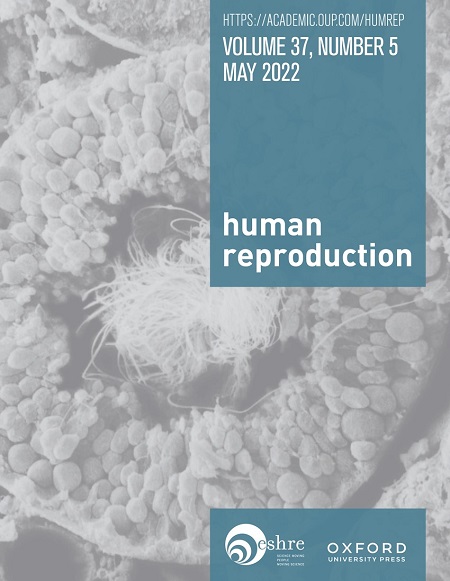Racial and ethnic disparities in fecundability: a North American preconception cohort study
IF 6
1区 医学
Q1 OBSTETRICS & GYNECOLOGY
引用次数: 0
Abstract
STUDY QUESTION To what extent are there racial and ethnic disparities in fecundability in North America? SUMMARY ANSWER In a North American preconception cohort study, we observed large differences in fecundability across racial and ethnic groups. WHAT IS KNOWN ALREADY Several studies in the United States (USA) have shown that Black women tend to wait longer for fertility treatment and are less likely to seek medical care for infertility than White women. Among those who seek infertility treatment, there are large racial disparities in access to treatment and treatment success rates. However, research has been limited and conflicting on the extent to which fertility measures such as fecundability (per-cycle probability of conception) vary by race and ethnicity. STUDY DESIGN, SIZE, DURATION We examined the associations of race and ethnicity with fecundability in Pregnancy Study Online (PRESTO), a prospective preconception cohort study of US and Canadian residents aged 21–45 years who were actively trying to conceive without the use of fertility treatment at enrollment (2013–2024). We restricted the analysis to 18 573 participants with fewer than 12 cycles of pregnancy attempt time at enrollment. PARTICIPANTS/MATERIALS, SETTING, METHODS Participants self-reported data on race and ethnicity on a baseline questionnaire and completed bimonthly follow-up questionnaires for up to 12 months to update data on pregnancy status. We estimated fecundability ratios (FRs) and 95% confidence intervals (CI) using proportional probabilities regression models. We stratified by pregnancy attempt time at enrollment, reproductive history, country of residence, age, and educational attainment. In sensitivity analyses, we applied inverse probability of continuation weights to account for differential loss-to-follow-up. We also calculated the cumulative incidence of infertility during 12 cycles of attempt time by race and ethnicity using life-table methods to account for censoring. MAIN RESULTS AND THE ROLE OF CHANCE Compared with non-Hispanic White participants, fecundability was appreciably lower among participants who identified as non-Hispanic Black (FR = 0.60, 95% CI: 0.52–0.70), non-Hispanic American Indian/Alaskan Native/Indigenous (FR = 0.70, 95% CI: 0.44–1.11), non-Hispanic multiracial (FR = 0.89, 95% CI: 0.81–0.99), or Hispanic other/unknown race (FR = 0.77, 95% CI: 0.65–0.90). Results were similar when we performed various sensitivity analyses including: application of inverse probability of continuation weights to account for differential loss-to-follow-up; stratification by age and educational attainment; and restriction of analyses to (i) participants with <3 cycles of pregnancy attempt time at enrollment, (ii) nulligravid participants without an infertility history, and (iii) US residents. The 12-cycle cumulative incidence of infertility (i.e. clinical definition) among participants with <2 cycles of attempt time at entry also differed meaningfully by race and ethnicity (33.2% among non-Hispanic Black participants and 29.7% among Hispanic other/unknown race participants vs 16.4% among non-Hispanic White participants). LIMITATIONS, REASONS FOR CAUTION Due to limited numbers, we grouped participants into broad racial and ethnic groups within which there is considerable heterogeneity. Such groupings will obscure any differences in fecundability that exist between subgroups. Differential loss-to-follow-up was an important source of selection bias, though findings did not vary appreciably when we applied inverse probability of continuation weights. PRESTO is an internet-based convenience sample of pregnancy planners of higher-than-average socioeconomic status and is, therefore, not representative of all individuals who conceive, which may limit generalizability. WIDER IMPLICATIONS OF THE FINDINGS These descriptive data indicate the strong need for additional studies to carefully measure and better understand the mechanisms underlying disparities in fecundability, including the effects of structural racism and discrimination, as well as programs and policies to advance reproductive health equity. As more research is conducted on the drivers of these disparities, greater efforts should be made to increase fertility awareness, enhance preconception health, expand access to fertility treatments, and improve patient care among underserved populations to reduce the burden of subfertility among those affected. STUDY FUNDING/COMPETING INTEREST(S) This work was funded by the Eunice Kennedy Shriver National Institute for Child Health and Human Development (R01-HD086742; T32-HD052458) and the National Institute on Minority Health and Health Disparities (K01-MD013911). In the past three years, L.A.W. served as a consultant for AbbVie, Inc. and the Gates Foundation. She was also a member of the steering committee for AbbVie on Abnormal Uterine Bleeding and Fibroids, where payments were made to Dr Wise. Her study, PRESTO, received in-kind donations from Kindara.com (fertility apps) and Swiss Precision Diagnostics (home pregnancy tests). C.N. received payments to her institution from the National Institute on Minority Health and Health Disparities K01-MD013911. The other authors have no competing interests to declare. TRIAL REGISTRATION NUMBER N/A.生育能力的种族和民族差异:北美孕前队列研究
研究问题:北美地区在生育能力方面存在多大程度的种族和民族差异?在一项北美孕前队列研究中,我们观察到不同种族和民族群体的生育能力存在很大差异。美国的几项研究表明,与白人妇女相比,黑人妇女等待生育治疗的时间更长,而且因不孕症寻求医疗护理的可能性更小。在寻求不孕症治疗的人群中,在获得治疗和治疗成功率方面存在很大的种族差异。然而,关于诸如可生育能力(每周期受孕概率)等生育措施在多大程度上因种族和民族而异的研究是有限和相互矛盾的。研究设计、规模、持续时间我们在妊娠在线研究(PRESTO)中研究了种族和民族与生育能力的关系,PRESTO是一项前瞻性孕前队列研究,研究对象是美国和加拿大21-45岁的居民,他们在入组时积极尝试怀孕而不使用生育治疗(2013-2024)。我们将分析限制在18573名入组时尝试怀孕时间少于12个周期的参与者。参与者/材料、环境、方法参与者在基线问卷上自我报告种族和民族数据,并完成为期12个月的两个月随访问卷,以更新妊娠状况数据。我们使用比例概率回归模型估计了受精率(FRs)和95%置信区间(CI)。我们根据入组时的妊娠尝试时间、生育史、居住国、年龄和受教育程度进行分层。在敏感性分析中,我们应用延续权的逆概率来解释差异的随访损失。我们还使用生命表方法计算了12个尝试周期内不同种族和民族的不孕症累积发生率,以解释审查。与非西班牙裔白人受试者相比,非西班牙裔黑人(FR = 0.60, 95% CI: 0.52-0.70)、非西班牙裔美洲印第安人/阿拉斯加原住民/土著(FR = 0.70, 95% CI: 0.44-1.11)、非西班牙裔多种族(FR = 0.89, 95% CI: 0.81-0.99)或西班牙裔其他/未知种族(FR = 0.77, 95% CI: 0.65-0.90)受试者的受孕率明显较低。当我们进行各种敏感性分析时,结果相似,包括:应用延续权的逆概率来解释差异的随访损失;按年龄和教育程度分层;并将分析限制在(i)入组时尝试怀孕时间为3个周期的参与者,(ii)无不孕史的无妊娠参与者,以及(iii)美国居民。在入组时尝试时间为2个周期的参与者中,12周期累积不孕症发生率(即临床定义)也因种族和民族而有显著差异(非西班牙裔黑人参与者为33.2%,西班牙裔其他/未知种族参与者为29.7%,非西班牙裔白人参与者为16.4%)。由于人数有限,我们将参与者分为广泛的种族和民族群体,其中存在相当大的异质性。这样的分组将掩盖子组之间存在的生育能力差异。差异随访损失是选择偏差的重要来源,尽管当我们应用延续权重的逆概率时,结果没有明显变化。PRESTO是一个基于互联网的方便样本,调查对象是社会经济地位高于平均水平的怀孕计划者,因此,它不能代表所有怀孕的个体,这可能会限制其普遍性。研究结果的更广泛含义这些描述性数据表明,迫切需要进一步的研究来仔细衡量和更好地理解生育能力差异的机制,包括结构性种族主义和歧视的影响,以及促进生殖健康平等的计划和政策。随着对这些差异的驱动因素进行更多的研究,应作出更大的努力,提高对生育的认识,加强孕前保健,扩大获得生育治疗的机会,并改善服务不足人口的病人护理,以减轻受影响人群的生育力不足负担。研究经费/竞争利益(S)这项工作由尤尼斯肯尼迪施莱弗国家儿童健康与人类发展研究所资助(R01-HD086742;T32-HD052458)和国家少数民族健康和健康差异研究所(K01-MD013911)。在过去的三年里,L.A.W.担任AbbVie, Inc.和盖茨基金会的顾问。她也是艾伯维异常子宫出血和肌瘤指导委员会的成员,该委员会向怀斯博士支付了费用。 她的研究PRESTO得到了Kindara.com(生育应用程序)和Swiss Precision Diagnostics(家用验孕棒)的实物捐赠。C.N.收到了国家少数民族健康和健康差异研究所(K01-MD013911)给她所在机构的付款。其他作者没有竞争利益需要申报。试验注册号n / a。
本文章由计算机程序翻译,如有差异,请以英文原文为准。
求助全文
约1分钟内获得全文
求助全文
来源期刊

Human reproduction
医学-妇产科学
CiteScore
10.90
自引率
6.60%
发文量
1369
审稿时长
1 months
期刊介绍:
Human Reproduction features full-length, peer-reviewed papers reporting original research, concise clinical case reports, as well as opinions and debates on topical issues.
Papers published cover the clinical science and medical aspects of reproductive physiology, pathology and endocrinology; including andrology, gonad function, gametogenesis, fertilization, embryo development, implantation, early pregnancy, genetics, genetic diagnosis, oncology, infectious disease, surgery, contraception, infertility treatment, psychology, ethics and social issues.
 求助内容:
求助内容: 应助结果提醒方式:
应助结果提醒方式:


